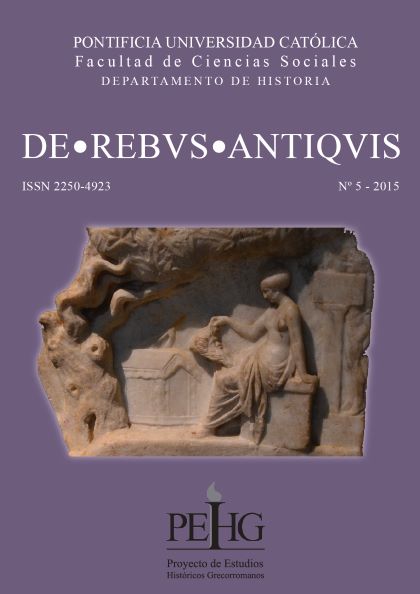Greek Gods in Christian Times: offering-poems of Agathias Scholasticus in Palatine Anthology 6
Keywords:
Agathias, sixth century AD, Greek Anthology, votive epigrams, religious world viewAbstract
Agathias was born ca. 536 in Mirina, Aeolian city of Misia, Asia Minor, on the western coast of modern Turkey. He cultivated poetry in Alexandria and moved to Constantinople in 554. He spent most of his life and died in this capital in 582 or 584. From the direct personal translation of the original Greek sources and the comprehensive analysis of the ὁλιγόστιχοι (between two and eight lines, always in even number), these reflections are restricted to Book 6, which assembles 358 dedicatory epigrams or ἀναθηματικά, religious offerings which operate as clarifying legends close to the donation. This research explores the motivations; the tone and the offerings granted to the divinity, with a triple purpose: to study the plastic-representative nature of their qualities and scopes, to consider the main elements of Agathias’ portrait and to justify the multivalent man-god relationship in these poetical documents. At the same time, it tries to look at the worries and interests of a writer in so advanced a Christian epoch, a poet who prefers to refer to gods who are apparently missing.
Downloads
References
BIBLIOGRAFÍA
Ediciones
CAMERON, A. (Trad.) (1993). The Greek Anthology from Meleager to Planudes. Oxford: Clarendon Press.
DÜBNER, Fred (1927). Epigrammatum Anthologia Palatina, cum Planudeis et appendice nova. Volumen primum. Parisiis: Editore Ambrosio Firmin-Didot.
PATON, W. R. (Trad.) (1958). The Greek Anthology (t. III.). London-Cambridge: Harvard University Press.
VALERIO, Francesco (2014). Agazia Scolastico. Epigrami. Introduzione, testo critico e traduzione. Venezia: Università Ca’ Foscari.
WALTZ, Pierre (Trad.) (1931). Anthologie Grecque (t. III, 2 vol.). Paris: Les Belles Lettres.
Bibliografía y diccionarios
CANTARELLA, Raffaele (1972). La literatura griega de la época helenística e imperial. Buenos Aires: Losada.
CARDETE DEL OLMO, María Cruz (2015). Entre Pan y el Diablo: el proceso de demonización del dios Pan, Dialogues d’histoire ancienne 1 (41/1). Paris: Presses Universitaires de Franche-Comté, 47-72.
CHANTRAINE, Pierre (1968). Dictionnaire Étymologique de la Langue Grecque. Histoire des mots. Paris: Klincksieck.
CHEVALIER, Jean y GHEERBRANT, Alain (2000). Diccionario de los símbolos. 7ª e., Barcelona: Herder.
CIRLOT, Juan-Eduardo (1995). Diccionario de símbolos. Barcelona: Labor.
CIVITA, Víctor (Ed.) (1973). Mitología (T. 1). Sâo Paulo: Abril Cultural.
CONSTANTELOS, Demetrios J. (1964). “Paganism and the State in the Age of Justinian”, The Catholic Historical Review. University of American Press, 372-380.
ERRANDONEA, Ignacio (Dir.) (1954). Diccionario del mundo clásico (2 vol.). Barcelona: Labor.
ESEVERRRI HUALDE, Crisóstomo (1988). Diccionario etimológico de helenismos españoles (3 vol.). Burgos: Aldecoa.
FERNÁNDEZ-GALIANO, Manuel (1969). La transcripción castellana de los nombres propios griegos. 2ª ed., Madrid: Sociedad Española de Estudios Clásicos.
GIL, Luis (1985). Censura en el mundo antiguo. 2ª ed., Madrid: Alianza Universidad.
GONZÁLEZ FERNÁNDEZ, Rafael (1990). La obra legislativa de Justiniano y la cristianización del cosmos, en González Blanco, Antonino y Blázquez Martínez, José María. Cristianismo y aculturación en tiempos del Imperio Romano (Antigüedad y Cristianismo. Monografías históricas sobre la Antigüedad tardía 7) Murcia: Universidad de Murcia.
HADAS, Moses (1987). Guía para la lectura de los clásicos griegos y latinos. México: Fondo de Cultura Económica.
HORNBLOWER, Simon & SPAWFORTH, Antony (Eds.) (1996). The Oxford Classical Dictionary. 3ª e., Oxford-New Press: Oxford University Press.
KALDELLIS, Anthony (1999). Agathias on History and Poetry, Greek, Roman, and Byzantine Studies 38. Durham: Duke University.
--- (2007). Hellenism in Byzantium: The Transformations of Greek Identity and the Reception of the Classical Tradition. Cambridge: University Press.
KÖHLMEIER, Michael (2005). Breviario de mitología clásica (vol. 3). Barcelona: Edhasa.
NILSSON, Martín Persson (1961). Historia de la religión griega. Buenos Aires: Eudeba.
OSTROGORSKY, Georgn (1984). “Capítulo 2. Rasgos generales del desarrollo del Estado Bizantino Temprano (324-610), Historia del Estado Bizantino. Madrid: Akal Editor, 37-98.
RODRÍGUEZ ADRADOS, Francisco (1981). “Dioses y hombres”, en El mundo de la lírica griega antigua. Madrid: Alianza, 61-81.
RUIZ DE ELVIRA, Antonio (1982). Mitología clásica. Madrid: Gredos.
VALLEJO GIRVÉS, Margarita (1997). “Tradiciones y pervivencias paganas en el imperio bizantino: el posicionamiento de Justiniano”, en Antigüedad y cristianismo: Monografías históricas sobre la Antigüedad tardía. Murcia: Universidad de Murcia, 217-228.
VIDAL GUZMÁN, Gerardo (2008). Retratos del Medievo. Madrid: Rialp.
Downloads
Published
How to Cite
Issue
Section
License










